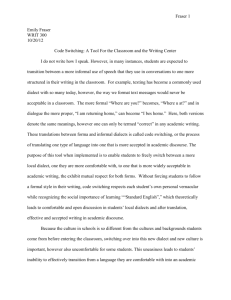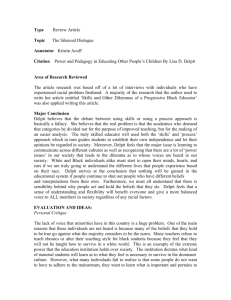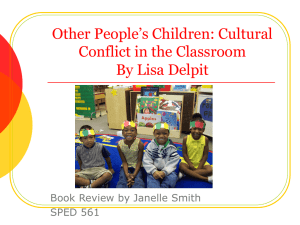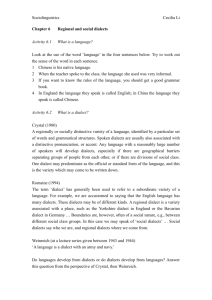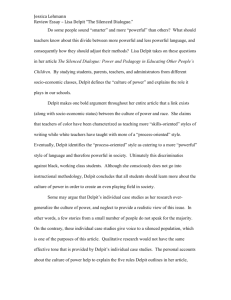Major Essay 2 - WordPress.com
advertisement
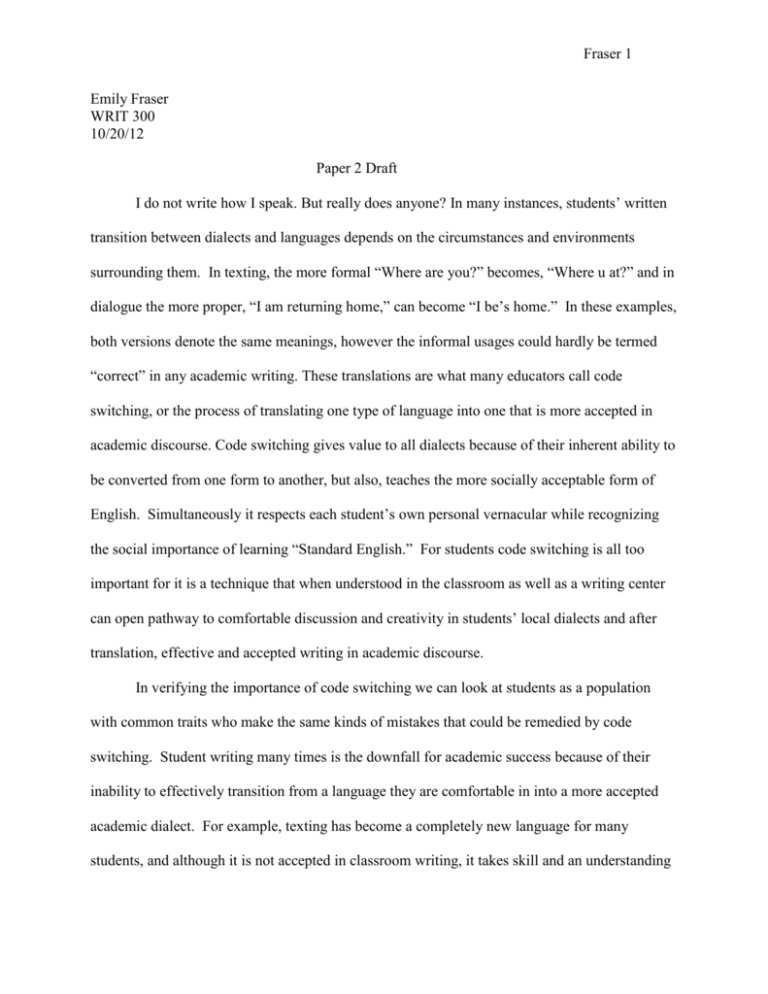
Fraser 1 Emily Fraser WRIT 300 10/20/12 Paper 2 Draft I do not write how I speak. But really does anyone? In many instances, students’ written transition between dialects and languages depends on the circumstances and environments surrounding them. In texting, the more formal “Where are you?” becomes, “Where u at?” and in dialogue the more proper, “I am returning home,” can become “I be’s home.” In these examples, both versions denote the same meanings, however the informal usages could hardly be termed “correct” in any academic writing. These translations are what many educators call code switching, or the process of translating one type of language into one that is more accepted in academic discourse. Code switching gives value to all dialects because of their inherent ability to be converted from one form to another, but also, teaches the more socially acceptable form of English. Simultaneously it respects each student’s own personal vernacular while recognizing the social importance of learning “Standard English.” For students code switching is all too important for it is a technique that when understood in the classroom as well as a writing center can open pathway to comfortable discussion and creativity in students’ local dialects and after translation, effective and accepted writing in academic discourse. In verifying the importance of code switching we can look at students as a population with common traits who make the same kinds of mistakes that could be remedied by code switching. Student writing many times is the downfall for academic success because of their inability to effectively transition from a language they are comfortable in into a more accepted academic dialect. For example, texting has become a completely new language for many students, and although it is not accepted in classroom writing, it takes skill and an understanding Fraser 2 of both text language and Standard English in order to switch between the two. In my own experience, translating text form into academic form can be challenging for many students because of how subconscious it has become. Even in something like grading a vocabulary tests in which students have to write a correct and complete sentence using their vocabulary word, simple things like grammar and spelling were marked off on one student’s test because he used, “U,” instead of, “you,” in his sentence.1 This is a common and understandable mistake made by many youth across cultural lines and only exemplifies the beginnings of issues student’s have in code switching from dialects and languages they are most comfortable with to those that are more accepted in academic discourse. There are varied dialects of varying degree of complexity when it comes to translating them, but all in all code-switching offers a way for students to feel knowledgeable and comfortable I the classroom if it is a skill they can learn. Even something as simple as translating a text message to full written form English is code-switching and if we can ask the majority of our students to do this daily, then I believe we can work our way up to understanding multiple dialects and their translations effectively. Much in the same line as this close to home texting example, the way that students speak in urban and rural schools many times differs from “Standard English,” however these dialects are so much more complex, so subconscious and tied to their home lives that lapses in translations can be hard to catch and easily managed in the wrong way. In the classroom, appreciation for a student’s cultural or linguistic background is the first step towards successful writing. Narrowing in on the writing of minority students, code switching can become more tedious as local dialects may stray farther away from Standard English. Delpit points out that the languages and dialects that students use in classroom writing is inherently tied with their home culture, the first places where they most likely learned some form of speaking and writing. In 1 Primary Source Fraser 3 light of these influential and valued connections, Delpit says, “To suggest that [their] form is ‘wrong’ or, even worse, ignorant, is to suggest that something is wrong with the student and his or her family.”2 In undervaluing a student’s way of writing or self-expression the teacher is undervaluing the culture the students learned to express themselves in. Asking students to adhere to the “correct” form of English is like asking a student what the correct way to make a hamburger is. We ask our students to write in the “correct” way, but correct to who? Even within grammar usage and English composition, rules are relative and as long as our point is clear, then the placement of a comma here or there will not make or break a paper. The classroom should offer a place of safety for students not just physically but mentally as well, and allow for exploration and experimentation. This place exists for some students, especially those who learn from Mr. Talbert, a teacher in an urban school district in the US. In his classroom, Mr. Talbert believes that teaching code switching to his multilingual students can lead to higher academic success and in addition, more effective student-teacher relations. One of Mr. Talbert’s students Stevo, a Puerto Rican student prefers to write in tag form, a graffiti style penmanship for his informal assignments. In allowing Stevo to do this, Mr. Talbert values his student’s personal form of cultural expression and in doing so creates a better and more respectable relationship with his students. Stevo tells us that he has only written in tag form since eight grade and Mr. Talbert realizes this and accommodates Stevo’s request to agree upon a form of communication for the purpose of his classroom writing.3 In allowing Stevo to write in tag, Mr. Talbert is affirming Stevo’s cultural ties but also impresses on him that tag form is not the common way of writing to move up through the 2 3 Delpit 53 Irizzary 25 Fraser 4 academic ladder. The article backs Mr. Talbert saying, “While it is important for student to have a mastery over a style of penmanship that is recognizable by the majority of teachers and future employers, it is equally important to note that students want those aspects of their culture that are important to them affirmed.”4 Mr. Talbert’s offers one form of code switching in allowing his students to write their thoughts in their familiar vernaculars and translate that to the more formal version in order to give them the best opportunity for success. The article acknowledges the societal implications for writing in such an informal way, but also emphasizes the importance of valuing student’s cultural backgrounds through their writing, which is also repeated by Delpit. Taking into account the types of students who are most likely to speak in alternative dialects of English, we have to understand their pathway to success and how difficult that will be because, “…it is equally important to understand that students who do not have access to the politically popular dialect form in this country, that is, Standard English, are less likely to succeed economically than their peers who do.”5 This implies that those students who speak in alternate vernaculars may be the most at risk students, those in the most need of this code-switching knowledge in order to succeed academically as well as socially. Now that we have verified that all students can take part and gain from code switching in their writing and in the classroom, we now go onto the tactical ways of effectively as well as ineffectively teaching this code switching. Delpit begins the discussion on linguistic diversity with a scene that many of us would be familiar with; a teacher correcting a student’s grammar usage concurrent with his own dialect but not hers. The teacher begins the conversation saying, “TEACHER: Good morning, Tony, how are you? TONY: I be's fine. 4 5 Ibid. 25 Delpit 53 Fraser 5 TEACHER: Tony,I said, How are you? Tony: (with raised voice) I be'sfine. TEACHER: No, Tony, I saidhowat'eyou? TONY; (angrily) I don.e told you 1 be's fine and I ain't te lling you no more!6 As opposed to Mr. Talbert’s easy-going and calm relationship with his students, this teacher confronts Tony in such a way that prescribes what he should say. Whether it be by cultural or language differences, the two codes of teacher and students have not been agreed upon and therefore do not meet up. In the end, this teacher’s ability to teach her student to code switch is stunted from the beginning in the lack of communication going on between parties and the teacher’s incapacity to bend on the formal rules of grammar. However, all is not lost on classroom teaching techniques for Delpit goes on to mention a few that more effectively deal with the mind field that is code switching. First, students may be allowed as they were in Mr. Talbert’s class to write in their own language for assignments and then take it upon themselves to understand and translate their own writings into more formal and traditional forms. Students can also develop bidialectal dictionaries7 that they as well as their teacher may use to translate informal writing assignments. This can be most successful in allowing the teacher to understand what the student is saying and correct them once they have fully transcribed their work. In addition having students role play8 and act out scenes from books and plays alike can help to not only break the tension formed in disconnects between dialects, but also familiarize students to the sound and rhythm of socially accepted Standard English so they may feel more comfortable switching in and out of their vernaculars on more occasions. However, the options do not end there. 6 Delpit 51 Ibid … 8 Ibid … 7 Fraser 6 Short and Echevarria bring up the issues of not just minority students, but all ELL students as well that can just as easily share in this communication divide. Under their model, the Sheltered Instruction Observation Protocol (SIOP)9 struggling learners that have issues code switching from their home (many times foreign) languages may find success in these structured lessons. First, the vocabulary of a lesson to those trying to translate may be uncertain so the model begins with focusing on language demands and objectives involved in the lessons.10 If this vocabulary can be defined even before the student learns it, those terms may be more usable in their translations. Farther down the process teachers can work to strengthen student’s background knowledge of certain topics that may be foreign to them. On the other side of the coin, teachers can take interest in what their students connect with and try to incorporate that into the class as well. The last step goes back to Delipt’s point of oral interaction in allowing students the opportunity to speak in the dialect they are being encouraged to learn they can become more familiar with is and therefore more likely to use it correctly in their own writing.11 9 Short and Echevarria 11 Ibid 11 11 Ibid 12 10 Fraser 7 Specifically in writing for the classroom Verify code-switching: in classroom and WC - Irizzary: Mr. Talbert - Blalock: writing for our audience, everyone kind of code-switches - Delpit (Language Diversity): affective filter, students after 4th grade chose to speak in local form to fit in with their environments maybe How-to code switch in classroom - Delpit: (student-teacher interaction- example of wrong way to go about code switching), bidialectal dictionaries, role play and reading out loud (familiarize speaking) - Irizzary: students can write in their own form (tag, Ebonics) and learn both - Short and Echevarria: Teacher Skills to Support English Language Learners o Move on from dialects into ELL students- can be just as effective Code-switch in writing center - tell students what they need to know in order to write in academic English o Grammar, principles… - Baron and Grimms?? - Still cause trouble: For a college student in Barron and Grimm’s “Addressing Racial Diversity in a Writing Center: Stories and Lessons from Two Beginners,” code switching However, it is not just the minority students who need to keep these societal impacts in mind. We all do it: Blalock12 indicates that code switching relies on a focus on the audience and their interpretation and expectations for a piece of writing. Regardless of what dialect students write in, the wrier needs to take ownership of their knowledge in order to formulate a sound paper. 12 Blalock

